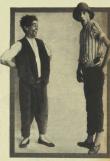Dinks and Oncus (Jack Paterson and George Wallace) were the most popular knockabout acrobatic comedy partnership ever to work for variety entrepreneur Harry Clay. Although they had no equal in being 'so well remembered purely from appearances there' (Katharine Brisbane, Entertaining Australia, p.178), the partnership was surprisingly brief, lasting only around four years (1920-1924).
Paterson and Wallace came together on Clay's circuit in early 1920, after having been initially engaged as solo performers, although they sometimes worked with other performers (Wallace, for example, worked briefly with his first wife after arriving in Sydney). Their immediate popularity on the Clay circuit was such that within a matter of weeks the two comedians began to invite interest from the Theatre Magazine and Australian Variety (the two leading industry magazines of the era):
'George Wallace says he has a century of the best to say that his partner, Dinky Paterson, can get a decision over Sid Godfrey in a twenty-round route, or he will have a four spar with him any night at the Gaiety just for old times sake (Australian Variety 22 July 1920, p.21).
'Dinks and Oncus ("The Two Drunks") never once become dull. They go from laugh to laugh, and get an exceedingly good reception' (Theatre Magazine August 1920, p.9).
'Dinks and Oncus stopped the show in their inebriate sketch at the Gaiety and had to take no less than four bows before the pleased patrons would allow them to retire' (Australian Variety 17 Sept. 1920, n. pag).
By the end of their first year together, Dinks and Oncus had become Clay's biggest attraction, playing to packed houses and rivalling Stiffy and Mo for the 'mob's' favouritism. Typical of their early routines is the following patter:
George Wallace: Yes, I'm acquainted with your wife, old man. I knew her before you married her.
Dinks Paterson: Ah, that's where you had the advantage of me - I didn't. (Australian Variety 24 June 1920, p.5).
Pint-sized Wallace was in marked contrast to the incredibly tall and skinny Paterson. Their knock-about style of comedy, containing lots of falling around, impersonations of drunks, spoofs on other variety acts, and outrageous boxing displays, created many hilarious routines. Charles Norman, an ex-Clay's performer and a one-time member of Wallace's revusical company, recalls the Wallace and Paterson partnership: 'When George was beginning to be talked about as an excellent comic he was teamed with another comedian, a man from the First World War, Dinks Paterson. Dinks was a tall, very thin comedian with a nose that somehow got in the way of a breach loader gun, or so it seemed. But he was one of the most likable blokes you'd meet from here to the Cape. This tall and self-effacing character was a gifted funny man. He had a voice that tended to rise to falsetto when aroused in blow-up comedy situations. "What's the matter with you?" he'd call. They were a perfect foil for each other, screamingly funny and seemed destined to become a world famous comedy team' (When Vaudeville was King, pp.105-6). The partnership was not always harmonious, however. Paterson recalls in 1960 that although Wallace was wonderful to work with, they had their share of off-stage arguments. Indeed, according to a report in Everone's in late 1921, the pair had almost decided to split up then but after some reflection decided the act was too successful to abandon at that stage (30 November 1921, p,20).
Although Dinks and Oncus continued to fill Harry Clay's theatres up until the end of their partnership, Paterson's involvement gradually lessened over the last year or so. Indeed, by around mid 1922, Clay had begun advertising 'Oncus and his Merry Company' (Theatre Magazine June 1922, p.17), which very likely rankled with Patterson. His decision to leave the partnership may also have occurred after a misunderstanding over a practical joke played on Trixie Ireland (Paterson's finacee) during a performance. According to Charles Norman, when Wallace, as company leader, tried to brush the incident off, Dinks took offence 'and as a result one of the world's best comedy acts split up' (p.106). After the pair ended their association, Wallace went almost immediately on to the Fullers' circuit, playing an extended season in Dunedin, New Zealand, before returning to Australia, where he quickly established himself as one of Australia's leading writers and producers of revusicals (see George Wallace and George Wallace Revue Company entries for further details). Jack Paterson formed a new stage partnership with Ireland (as Dinks and Trixie) and, following their engagement in the Hugh J. Ward/Fullers' 1924 Christmas pantomime Cinderella (Princess Theatre, Melbourne), the couple left to work the United Kingdom's variety circuits. They came back to Australia in 1929 and appeared on the Tivoli circuit, but with regular employment opportunities becoming more difficult to secure, they returned once more to Britain, remaining there until the late 1940s (see Jack Paterson's entry for further details).
 4638415672432737168.jpg
4638415672432737168.jpg